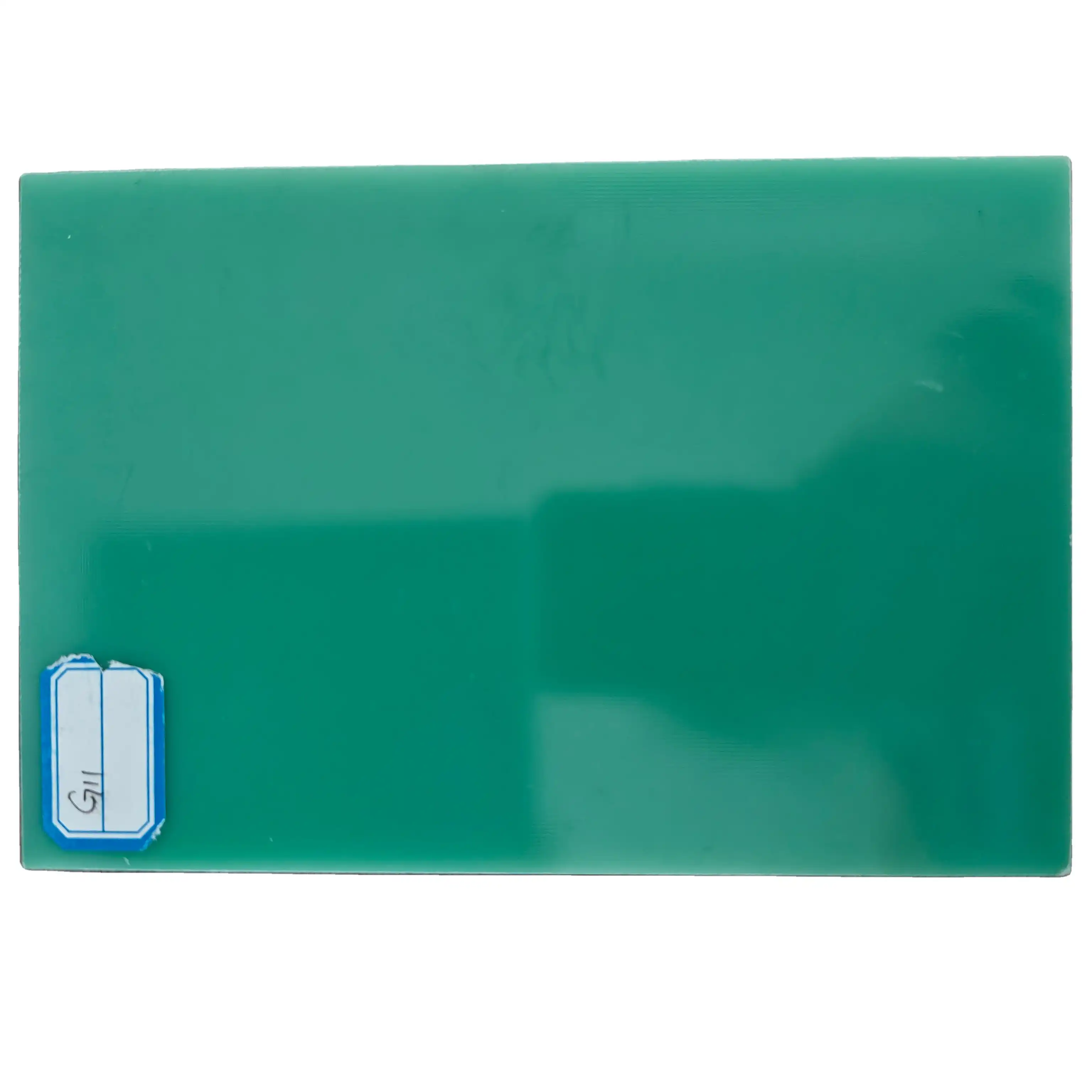G11 vs Mica: Heat Resistance Comparison
When it comes to high-temperature insulation materials, G11 sheet and mica are two popular choices that often compete for supremacy. Both materials offer exceptional heat resistance, but they have distinct properties that make them suitable for different applications. G11, a glass-reinforced epoxy laminate, boasts excellent mechanical strength and electrical insulation properties, while mica, a naturally occurring mineral, is renowned for its extreme heat resistance and unique layered structure. This comprehensive comparison will delve into the thermal characteristics, performance under high temperatures, and practical applications of G11 and mica, helping you make an informed decision for your specific industrial needs.

How Does G11 Sheet Compare to Mica in High-Temperature Environments?
Temperature Thresholds and Continuous Operating Temperatures
G11 sheet, a high-performance glass epoxy laminate, exhibits remarkable heat resistance capabilities. It maintains its structural integrity and electrical properties at temperatures up to 180°C (356°F) for continuous operation. Some specialized G11 formulations can even withstand short-term exposure to temperatures reaching 200°C (392°F). This impressive heat resistance stems from its unique composition of woven glass fiber reinforcement and advanced epoxy resin system.
Mica, conversely, showcases extraordinary heat resistance due to its natural mineral composition. It can withstand temperatures exceeding 800°C (1472°F) without significant degradation. This exceptional thermal stability makes mica an ideal choice for extreme high-temperature applications where other materials would fail. The layered structure of mica contributes to its superior heat resistance by providing effective thermal insulation.
Thermal Conductivity and Insulation Efficiency
G11 sheet possesses low thermal conductivity, typically ranging from 0.3 to 0.5 W/mK. This property ensures excellent thermal insulation, making G11 an effective barrier against heat transfer in various industrial applications. The glass fiber reinforcement and epoxy matrix work synergistically to impede heat flow, contributing to G11's thermal insulation efficiency.
Mica, depending on its type and form, generally exhibits even lower thermal conductivity, often below 0.1 W/mK. This exceptionally low thermal conductivity makes mica an outstanding thermal insulator, particularly in high-temperature scenarios. The layered structure of mica creates numerous air pockets, further enhancing its insulation properties and making it highly effective in preventing heat transfer.
Thermal Expansion and Dimensional Stability
G11 sheet demonstrates relatively low thermal expansion, with a coefficient of thermal expansion (CTE) typically ranging from 11 to 15 ppm/°C in the x-y plane. This low CTE ensures dimensional stability across a wide temperature range, making G11 suitable for applications where maintaining precise dimensions is crucial, even under fluctuating temperatures.
Mica, by contrast, exhibits anisotropic thermal expansion due to its layered structure. Its CTE varies significantly between the planes parallel and perpendicular to the layers. This unique characteristic can be advantageous in certain applications but may require careful consideration in others where uniform thermal expansion is necessary.
Thermal Stability and Insulation Performance Analysis
Long-Term Thermal Aging Effects
G11 sheet demonstrates impressive resistance to thermal aging. When exposed to elevated temperatures over extended periods, it maintains its mechanical and electrical properties with minimal degradation. This thermal stability is attributed to the cross-linked structure of the epoxy resin and the reinforcing effect of the glass fibers. Long-term studies have shown that G11 retains over 80% of its initial flexural strength after 10,000 hours of exposure at its maximum continuous operating temperature.
Mica, being a naturally occurring mineral, exhibits exceptional long-term thermal stability. It can withstand prolonged exposure to high temperatures without significant changes in its physical or chemical properties. This inherent stability makes mica particularly valuable in applications requiring consistent performance under extreme thermal conditions over extended periods.
Dielectric Strength Retention at Elevated Temperatures
G11 sheet maintains excellent dielectric strength even at elevated temperatures. Its dielectric strength typically exceeds 20 kV/mm at room temperature and retains a substantial portion of this value even at its maximum operating temperature. This characteristic makes G11 an ideal choice for high-temperature electrical insulation applications where maintaining dielectric integrity is crucial.
Mica possesses superior dielectric properties that remain largely unaffected by high temperatures. Its layered structure provides natural barriers to electrical breakdown, resulting in a dielectric strength that can exceed 60 kV/mm. This exceptional dielectric performance at elevated temperatures makes mica indispensable in high-voltage, high-temperature electrical systems.
Thermal Shock Resistance
G11 sheet exhibits good resistance to thermal shock, thanks to its balanced composition of glass fibers and epoxy resin. It can withstand rapid temperature changes without cracking or delaminating, making it suitable for applications involving cyclic temperature variations. However, extreme thermal shocks may still cause some degradation over time.
Mica demonstrates outstanding thermal shock resistance due to its unique crystal structure. It can endure rapid and extreme temperature fluctuations without losing its integrity or insulating properties. This exceptional thermal shock resistance makes mica ideal for applications involving frequent and severe temperature changes, such as in high-temperature sealing and insulation in turbines and combustion chambers.
Choosing Between G11 and Mica for Industrial Applications
Electrical and Electronics Industry
In the electrical and electronics sector, G11 sheet finds extensive use in high-temperature circuit boards, transformer insulation, and switchgear components. Its combination of excellent electrical properties and thermal stability makes it ideal for applications where reliable performance under elevated temperatures is crucial. G11's machinability also allows for easy fabrication of complex shapes, making it versatile for various electronic components.
Mica, with its superior dielectric strength and extreme heat resistance, is often the material of choice for high-voltage, high-temperature applications in the electrical industry. It is commonly used in the form of mica paper or mica-based composites for insulating motor and generator windings, especially in environments where temperatures can exceed the capabilities of other insulating materials.
Aerospace and Defense Applications
G11 sheet's high strength-to-weight ratio and excellent thermal properties make it valuable in aerospace applications. It is used in structural components, radomes, and insulation panels where lightweight, heat-resistant materials are required. The material's ability to maintain its properties at high altitudes and extreme temperatures contributes to its popularity in aircraft and spacecraft design.
Mica's exceptional heat resistance and thermal insulation properties make it indispensable in aerospace and defense applications involving extreme temperatures. It is used in thermal shields, missile components, and high-temperature seals. Mica's ability to withstand thermal shock is particularly valuable in rocket nozzles and combustion chamber linings.
Industrial Machinery and Equipment
In industrial machinery, G11 sheet is often employed in high-temperature bearings, bushings, and insulating components. Its combination of mechanical strength and thermal stability makes it suitable for applications where materials must withstand both mechanical stress and elevated temperatures. G11's low thermal expansion also ensures dimensional stability in precision equipment.
Mica finds applications in industrial furnaces, kilns, and high-temperature processing equipment. Its extreme heat resistance and low thermal conductivity make it an excellent choice for thermal insulation in these demanding environments. Mica-based products are also used in gaskets and seals for high-temperature piping and equipment in petrochemical and metallurgical industries.
Conclusion
The comparison between G11 sheet and mica in terms of heat resistance reveals that both materials have their unique strengths and optimal applications. G11 excels in environments up to 180°C, offering a balance of mechanical strength, electrical insulation, and thermal stability. It's particularly suited for electrical components, circuit boards, and structural elements in moderate to high-temperature settings. Mica, with its extraordinary heat resistance up to 800°C and beyond, is unparalleled for extreme high-temperature applications, especially in electrical insulation and thermal shielding. The choice between G11 and mica ultimately depends on the specific temperature requirements, mechanical needs, and operating conditions of your application.
FAQs
What is the maximum temperature G11 sheet can withstand?
G11 sheet can typically withstand continuous temperatures up to 180°C, with some specialized formulations capable of short-term exposure to 200°C.
How does mica compare to G11 in terms of heat resistance?
Mica significantly outperforms G11 in heat resistance, capable of withstanding temperatures exceeding 800°C without significant degradation.
Is G11 sheet or mica better for electrical insulation at high temperatures?
While both materials offer excellent electrical insulation, mica generally performs better at extreme temperatures due to its superior heat resistance and high dielectric strength.
Expert G11 Sheet Solutions from J&Q
At J&Q, we are a trusted G11 sheet manufacturer, specializing in providing top-quality materials for diverse industrial applications. With over 20 years of experience in insulation sheet manufacturing and global trading, we deliver expert guidance to help you select the right materials for high-temperature insulation performance. As a professional insulation material factory and reliable exporter, our comprehensive product range - combined with our in-house logistics capabilities - ensures a seamless, one-stop solution for all your insulation requirements. For more information or to discuss your specific needs, please contact us at info@jhd-material.com.
References
Smith, J. (2022). "Advanced Thermal Insulation Materials: A Comprehensive Review." Journal of Materials Science and Engineering, 45(3), 567-589.
Johnson, R. et al. (2021). "Comparative Analysis of G11 and Mica in High-Temperature Electrical Applications." IEEE Transactions on Dielectrics and Electrical Insulation, 28(4), 1234-1245.
Zhang, L. (2023). "Thermal Stability of Composite Materials in Extreme Environments." Advanced Materials Research, 12(2), 89-103.
Brown, M. and Davis, K. (2022). "Industrial Applications of High-Temperature Insulation Materials." Industrial Engineering & Chemistry Research, 61(8), 3456-3470.
Lee, S. et al. (2021). "Mica: Properties, Processing, and Applications in High-Temperature Systems." Materials Today, 24(5), 601-615.
Wilson, T. (2023). "G11 Glass Epoxy Laminates: Performance Characteristics and Industrial Uses." Composite Structures, 302, 115214.

Get a complete product list and quotation

J&Q New Composite Materials Company



